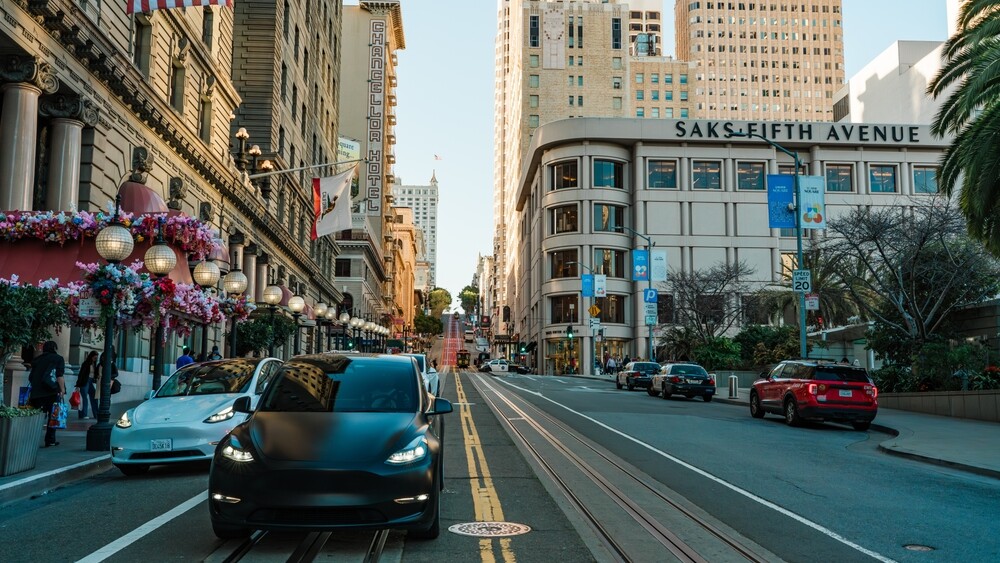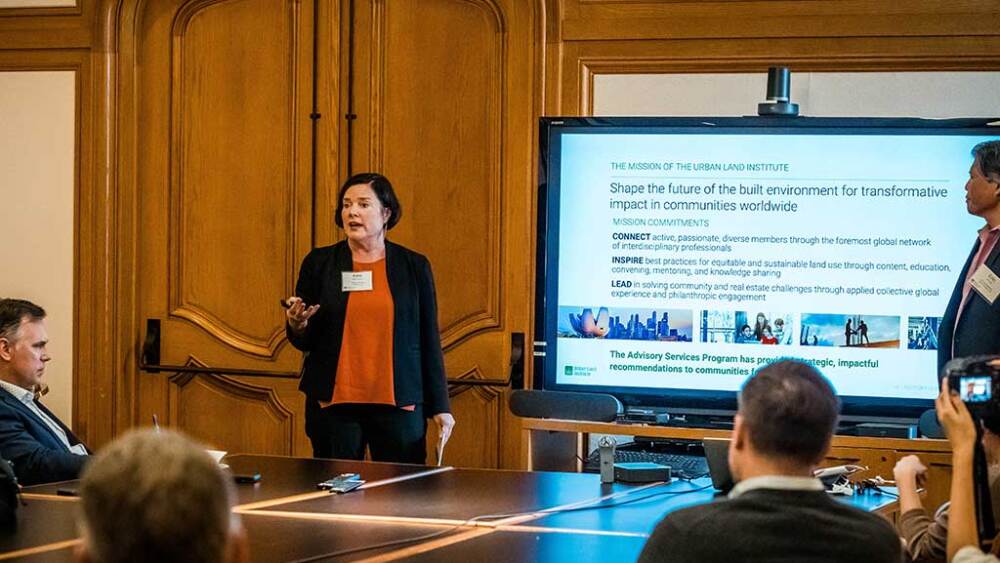The day before ULI San Francisco held a June panel discussion titled “Taking It to the Streets: Boosting Street Life to Revitalize Downtown San Francisco,” the San Francisco Chronicle published an article underscoring the area’s difficulties. It cited data from Avison Young suggesting that 18 years may pass before downtown returns to its pre-pandemic office vacancy rate.
In her opening remarks, the panel’s moderator—Geeti Silwal, principal and western region urban design leader for Perkins & Will—acknowledged the article and the challenges ahead. “March 2020 was when we left our downtown, and it needs help,” she said. “The economy is hurting, the businesses are hurting, the social life is hurting, and our identity—our reputation across the globe—is hurting. We are known to be an economy of innovators and entrepreneurs, so we have to create the innovation and the partnerships that are necessary to bring back vibrancy to our downtown.”
For decades, downtown relied on finance and tech companies to fill its office buildings. “This is a chance for us to reset the stage, make downtown more sustainable for businesses of all types, and open the gates to more cocreators and entrepreneurs,” Silwal said. “How can we embed sustainability and equity so that we are resilient and not subject to the swings of just a couple of industries whose employees have the privilege and the possibility of working from home?”
A crucial strategy in diversifying downtown is the curation of the street level to bring in many different players, she said. “How can we have a place that offers a comfortable, inviting, and engaging experience? How are we making opportunities for different types of businesses to be profitable? How do we enable, through our initiatives, a culture of connectedness to play out on the ground plane?”
A roadmap to the future
Sarah Dennis-Phillips, executive director of the San Francisco Office of Economic and Workforce Development, pointed out that the city has made a lot of progress already. The city released its Roadmap to Downtown San Francisco’s Future in February 2023, detailing a wide range of strategies for downtown rejuvenation. In May 2023, a ULI Advisory Services Panel convened to help San Francisco prioritize implementation actions and policy changes to revive downtown (https://knowledge.uli.org/en/reports/aspr/2023/san-francisco-ca-advisory-services-panel-report). “That work really spurred the city into action, and while there’s still a lot more to do, we have some proof of concept,” Dennis-Phillips said.
For example, “There are events happening throughout downtown … with some of [their] funding coming from our office, a lot from our partners and [community benefit districts such as] the Downtown SF Partnership, [and] some of them completely private sector–funded, like the Downtown First Thursdays street party,” Dennis-Philips said. Bhangra & Beats, a free Friday night market launched last year by the Office of Economic and Workforce Development in partnership with small businesses, brought a total of 30,000 people to the financial district on three nights during 2023, according to Dennis-Phillips.
Pop-up program
Also during last fall, the city kicked off the Vacant to Vibrant program with its first cohort, 17 pop-ups. “Most were retailers or food and beverage services, but we also had a radio station and an arts pop-up,” Dennis-Phillips said. “In partnership with the nonprofit SF New Deal, we were able to find building owners willing to dedicate their ground floors [to the program], and we found new or nascent small businesses to launch or expand into an empty storefront downtown.”
The first cohort’s members occupied their spaces for three to six months. “The majority of them went on to sign long-term leases, and we launched the second cohort about a month ago,” she said. “We’re hoping to [expand the program to include] 100 small businesses over the next year.”
State and federal funding
Saharnaz Mirzazad, executive director of the Governor’s Office of Planning and Research, spoke about ways her agency helps cities such as San Francisco to revitalize their downtowns. “We have multiple programs at the state level that support development infrastructure, such as the Infill Infrastructure Grant Program,” she said.
Federal funding provides a further valuable resource, Mirzazad noted. “Thanks to the Biden administration, we have seen an influx of funding at the federal level, and there are opportunities that you shouldn’t miss,” she said. “We’re trying hard to make sure that California takes advantage of [them] to improve our infrastructure, our streets, and our cities.”
Most of the federal funding sources focus on the areas of energy and transportation, but many of them present opportunities for downtown revitalization. “It takes a creative solution to figure out how they can be used at the local level,” she said. “Please don’t pay attention to the title of the funds. For instance, many funds related to housing have transit-related aspects.” Partnerships can be crucial. Mirzazad urged the panel’s attendees to “see how you can be part of something bigger, how you can work with small businesses to make something happen.”
Strengthening the public realm
Claude Imbault, deputy director of Downtown SF Partnership, a nonprofit community benefit district, spoke about the private sector’s efforts to strengthen the public realm. “When we formed four years ago, during the pandemic, the city had its hands full just ensuring that … residents were safe,” Imbault said. “To help the downtown, we created a public realm action plan … for implementing those strategies [by] using money from our assessments to seed projects throughout the downtown area.”
The resulting plan, developed by SITELAB Urban Studio, won an Innovation by Design Award from Fast Company in the Pandemic Action category. “It informed the mayor’s downtown recovery plans, and Sarah’s department provided seed money for us to do events, including Let’s Glow SF,” an annual holiday event that projects artwork onto downtown towers, Imbault said. “It brought in 70,000 people over a 10-day period.”
San Francisco’s downtown does not have any public parks, but it does have some privately owned public open spaces, and they too can play a role in reviving the streets. SHVO—which, alongside Deutsche Finance America, purchased the Transamerica Pyramid Center in 2020—is renovating the center’s iconic office tower and its two other buildings, as well as a redwood grove at the heart of the complex. “There’s nothing [else] like the grove in downtown San Francisco or, really, anywhere in San Francisco,” said Chris Trotier, senior director of SHVO.
SHVO hired the architecture firm Foster + Partners to lead the revamp of the site. “They told us, ‘For the last 50 years, this has been three buildings surrounding a redwood grove—let’s make it three buildings within a redwood grove,’” he said. “So, we’re expanding the green space, and we’re adding trees to the plaza and new planting within the Redwood Park.”
To activate the grove, SHVO will have a calendar of monthly cultural events, including art installations and tree lightings. New ground-floor shops at the complex will further encourage foot traffic. “We’re trying to make this [place] the town square of San Francisco for everyone,” Trotier said. “Whether you’re a tourist or a resident or an office worker, there will be something to do at all hours of the day, every day of the week.”
The 2023 ULI Advisory Services panel was possible through the resources and partnership between the ULI Foundation, ULI Terwilliger Center for Housing, ULI San Francisco, and ULI Advisory Services.








